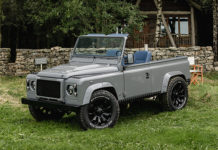Heritage Day is a South African public holiday, celebrated on 24 September every year. But what exactly is South African heritage?
According to South African History Online: “When people talk about South African heritage, they might be referring to anything from famous stretches of coastline in KwaZulu-Natal, to shweshwe fabric, to Bunny Chow. Heritage is therefore something quite personal. Yet heritage also includes that which is part of the national consciousness.”
With that in mind, braais and bakkies, or barbeques and pickups as they are known elsewhere in the world, definitely form part of the latter – the braai is a much-loved national past-time, bringing families, friends and communities together for shared meals the country over; while the locally-built Ford Ranger is one of South Africa’s best-selling vehicles, proving just how much we, as a nation, love our bakkies.
This year, to commemorate the ubiquitous bakkie as a part of South Africa’s proud national heritage, Ford Motor Company of Southern Africa commissioned a team from its own Paint Shop at the Silverton Assembly Plant in Pretoria to #BringIt – by transforming a range-topping 2019 Ranger Wildtrak into a one-of-a-kind piece of mobile art.
From design concept to completion, using paint brushes, spray guns and 35 litres of automotive paint, it took a team of five artists, three sprayers, and one assembler a total of 650 hours – mainly outside of their regular shift work at the plant – to produce the finished artwork.
Adorned with a giant national flag stretching all the way from below the imposing grille, up and across the bonnet, then over the roof of the double cab, the vehicle’s tailgate is decorated with Ndebele tribal art and a map of South Africa showing the location of Ford’s plants in Gauteng and the Eastern Cape. The collages flanking both the driver and passenger sides of the vehicle depict an eclectic array of cultural artefacts and aspects of environmental significance to South Africa and its people, including proteas – our national flower – and ancient San rock art.
“It is a great privilege to be part of the team that worked on this incredible project, and delivering a product that every Ford employee from every cultural background can be proud of,” said Queeneth Buthelezi, who led the project.
“What stands out for me about this project is how it merges South Africa’s various cultural and heritage symbols and artefacts into one cohesive unit, just like how Ford brings together people from different backgrounds who work towards one common goal,” added Wiseman Mngadi.
Tebogo Mohlala’s skill with a paintbrush was acknowledged by his co-workers who commented on how life-like his zebras on the side of the Ranger were, while Thabiso Magane’s depiction of a Tsonga village gained the admiration of onlookers.
“The project was a great learning experience for me, and an opportunity to demonstrate my skills,” said Alana Jansen. “It validates my ability and competence as a woman in the automotive industry.”
“David Serithi and Given Manzini did the spray work on the flag,” said Johan Fourie, Paint Shop Area Manager. “The final process, which requires three layers of clear coat with some preparation in between, followed by two hours of baking for each layer, was done by Daniel Malinga, while Ben Manala was responsible for reassembling the vehicle. The result is absolutely fantastic, and there is no question that we have exceptional talent in our team.”
“I was awestruck when I saw what the employees at Ford’s Paint Shop had achieved with this project,” said Carl Buchling, Technical Site Manager, Axalta Coating Systems South Africa, who donated the paint. “I am glad that we were able to play a part in turning into a splendid reality the vision that the team had for this project.”
“I don’t think Henry Ford – who once famously said: ‘Any customer can have a car painted any colour that he wants so long as it is black’ – could ever, in his wildest dreams, have pictured how incredible all these colours on just one vehicle would be!” said Ockert Berry, VP Operations, Ford Middle East and Africa. “But we have no doubt that he would be immensely pleased with what we have achieved.”
Bakkies have come a long way since 1926 when Ford launched the Model T Runabout, which was the world’s first factory-built, mass-produced pickup. The Ranger, which is also one of South Africa’s biggest success stories in terms of vehicle exports, is a remarkably versatile vehicle. It is both stylish and rugged, providing the comfort and technology of a passenger car, with the benefits of a capable workhorse.
Unlike many art cars around the world, the Heritage Ranger is a fully functional vehicle, right off the same assembly line as all the other South African-built Ranger models, Ranger Raptor off-road performance pickups, and Everest sports utility vehicles. It has been fitted with a big 3.2-litre diesel heart, built on the same assembly line as all the other engines at Ford’s Struandale plant in Port Elizabeth.
“This very special Heritage Ranger is built for South Africans, by South Africans,” concluded Berry. “It is both a tribute to Ford’s proud 96-year manufacturing history locally, as well as a fitting representation of our nation’s rich heritage and diversity.”
Provided by Ford SA





























